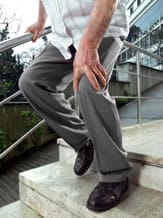Do you feel some pain in one or more of your joints ? Does anyone in your family suffer from osteoarthritis ? Would you like to know more about the symptoms of osteoarthritis and how to get a diagnosis ?
Pain
Pain is the main symptom. It varies according to the joint involved.
The characteristics of the pain of osteoarthritis are very specific:
- It is triggered and increased by movement.
- It ceases or decreases when the joint is at rest.
- It is less significant in the morning, then increases during the day and is at its maximum in the evening.
- It commonly makes falling asleep more difficult but may exceptionally lead to waking up during the night.
- It reappears every time the joint in question is subjected to exertion: walking for hip osteoarthritis, going upstairs for the knee, raising your arm for the shoulder.
But why does it hurt?
In fact, in osteoarthritis, it is the inflammatory reaction that is painful rather than the degeneration of the cartilage. This explains why some cases of pain-free osteoarthritis suddenly become quite painful, often from trauma or microtrauma. It is the latter that causes a painful inflammatory reaction. This pain is found on mobilisation of the joint involved during the clinical examination.

How can you assess your pain?
It is difficult to assess pain as each person expresses their feelings to a lesser or greater extent: It is a very subjective notion. Some people are "tough nuts" and speak little of their pain, while others are more "sensitive". To help your doctor to quantify your sensation of pain, there are tools for pain self-evaluation that you complete yourself. This will allow you to present your results to your doctor during a consultation.
There are three main types: (Source : DGS)
Functional impairment

Limitation in certain movements depends most of all on the pain involved. Your joints are sensitive and lack flexibility. The ease and extent of your movements have decreased. All these changes make your movements painful and everyday tasks more difficult to accomplish. This applies, for example to opening a jar of mayonnaise or going up the stairs. Indeed, the functional impairment corresponds to the limitation in mobility of the joint affected by osteoarthritis.
It varies depending on the activity of the person. Thus, a golf player will be much more bothered by osteoarthritis of the knee than a subject not practising a sport. Just as a violinist will be very handicapped by osteoarthritis of the fingers, however slight.
Osteoarthritic joints are, in general, neither red nor hot. They may be swollen when liquid becomes established in them (synovial effusion), something that is particularly common in the knees.
Later, you may be able to see the presence of small lumps or nodules, mainly on the fingers and toes. Eventually, bone spurs or osteophytes can cause joint deformity, especially visible in the hands and knees. Your general condition is always good. There is neither fever nor weight loss. However, osteoarthritic lesions are irreversible and sometimes lead, in addition to deformity, to joint stiffness which may progress to partial infirmity. Only osteoarthritis of the knee and hip can lead to significant disability, assessed by walking distance, according to Lequesne's functional index.
The following signs: crackling, a jarring sensation and pseudo-blocking are of no interest to the diagnosis even if they can be very distressing.



















